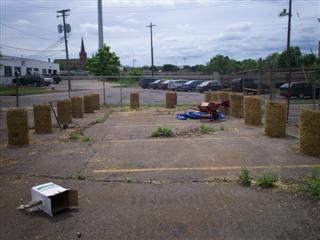Grown indoors, the weather was finally nice enough to bring all the little starts out into the sun. There they waited with baited breath for the farm to take shape.
....and they waited, and waited.. until they thought the day would NEVER arrive!

... once the action got under way, the first element to take its place were the 'living fence posts', otherwise known as the Potato Towers. To read all about their creation, read this blog entry.
The first order of business was to lay down a plastic layer that would prevent the plant roots from interacting with the asphalt. And then it was time to schlep some soil!
... and let me tell you, was there some soil to schlep.. Approximately 65 cubic yards of topsoil blended with leaf compost and composted cow manure (a 50-30-20 blend from Kern Landscaping) were moved via wheelbarrow using nothing other than a local food powered urban farmer.
How is that for sustainable. Okay, granted, it was exhausting too...
The field begins to take shape! As the soil is filled in, the beds are formed into a fun leaf-shaped pattern (unfortunately only appreciated from a birds-eye view).
As each section of the farm was completed, it was planted out before heading onto the next section. Those plants thought they had died and gone to plant heaven.... (which they very nearly did!)
The planting scheme used the ideas of Biointensive Gardening. As the name implies, the beds are planted very densely to reduce evaporation and inhibit weed germination. (See picture below.) This method requires a gardener/farmer to faithfully adhere to a stringent soil fertility management plan, due to heavy pressure placed upon it.


And things are GROWING! The speed at which this farm burst forth could only be attributed to the plants deep desire to express their their inner nature.. okay, well, perhaps also due to an excellent growing season here in the city.

 |

And it's harvest time!


It's always fun seeing before and after shots!


From baby potato sprouts to a full-blown potato tower...
The melons are reaching towards the blacktop.

Of course, no farm is complete without a composting system. Here is an example of a simple 2-stage compost bin made from wooden pallets gathered for free from a local company. Crafty re-use of resources lays at the heart of this endeavor.
Amaranth will always be close at hand when this farmer is on the scene. Not only is it an amazingly stunning plant in the garden, it also is edible as a young green, or one can harvest the protein-packed seeds. Guaranteed if you don't eat them, the birds will help themselves.
An early morning view of the melon field.

 I told you I loved the amaranth!
I told you I loved the amaranth! 
Another example of the intensively planted beds.









... hope you enjoyed the 2010 picture story. Stay tuned for 2011 as it unfolds!
















